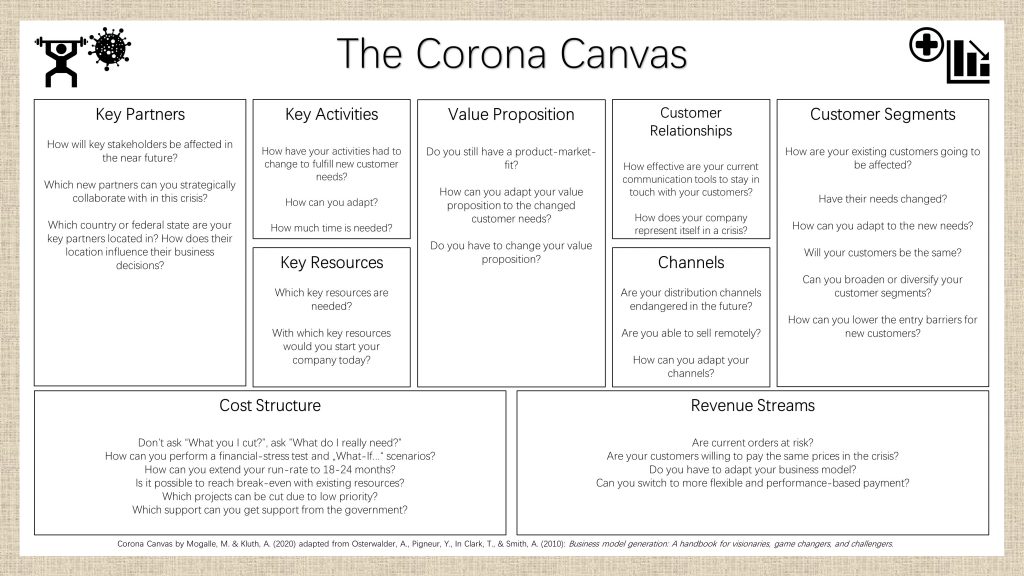The Corona Canvas: How you can deal with the crisis as a founder
In The News
25 Mar 2020
The current situation is clearly severe and much worse than anyone thought four weeks ago. Based on the latest developments and on experiences of the crises in 2000/1 and 2007/8, we would like to give you a short assessment of what it means for your business and how to cope with it. In a nutshell: It’s all about how to survive the next two the three years without any external financing.
1. How does the COVID-19 virus affect the economy?
There will be a dramatic economic downturn which will probably last for 1-3 years:
- Reported infections are increasing exponentially by >15-30% daily in Germany. Actual infections are probably 5-10 times higher than the official numbers as only people depicting severe symptoms are currently getting tested.
- Experts say that the pandemic cannot be stopped any longer in Europe but can mainly be slowed down through physical distancing.
- There is a high likelihood we may be tied to our homes for months – with all the consequences for economic life (unless a vaccine is found in the short term).
Goldman Sachs Chief Economist Jan Hatzius says: “The global economy is not just experiencing a recession, but a sudden stop without precedent in postwar history.” Kenneth Rogoff writes: “We are experiencing the first truly global crisis since the Great Depression of 1929.” And Nobel laureate Robert Shiller adds: “The crisis is still underestimated.” Therefore, it is highly likely that the crisis will last much longer and affect the economy far more than previous crises. We may be looking at an impact of two to three years.
2. What does this mean for you?
It’s all about how to survive now. Why?
- Revenues will go down quickly as existing projects will be postponed or cancelled (even signed ones). Acquisition of new projects and customers will come to a virtual standstill, because no one will spend. In a crisis the tendency is to stick to what you know and avoid experimenting with unknowns. The current business model and pricing might not work any longer.
- The financing environment could also collapse, i.e. private investors – angels, VCs – may focus on their existing investments rather than making new investments.
This means:
- Revenues will decrease faster than you are able to cut costs.
- Prepare to survive these challenging times ahead without any financing over the next quarters. Extend your run-rate anticipating much lower revenues. Whenever possible, try to reach break-even.
- Adapt to a completely different situation as quickly as possible. The world has changed, so you have to change.
It is clear that the outlook for your business has changed for the worse, so you cannot run your business as planned four weeks ago. Instead you have to switch from a growth mindset to a survival mindset focusing on solutions that can sustain the company to ride this wave. Imagine you are restarting your business in this new changed environment. This in itself presents a fresh new opportunity for your venture.
Or as Sequoia (05.03.2020) wrote:
“Having weathered every business downturn for nearly fifty years, we’ve learned an important lesson – nobody ever regrets making fast and decisive adjustments to changing circumstances. In downturns, revenue and cash levels always fall faster than expenses. In some ways, business mirrors biology. As Darwin surmised, those who survive “are not the strongest or the most intelligent, but the most adaptable to change.”
3. The Corona Canvas: How can you adapt?
During the crises in 2000/1 and 2007/8, many people underestimated their severity and how long they would last. Only short term contingency plans were made which were not sustainable. This current crisis is even more severe and will last longer because the entire world and every economic activity is affected. While all three crises have many differences, we can still draw certain lessons from them.
As a founder, it makes sense to expect the worst case scenario to secure the existence of your venture. To prepare for this, we recommend two things:
- Take your worst expectations and multiply them by 2 or 3. Based on these expectations create a worst-worst-worst case scenario, thereby ensuring preparedness (1).
- We have adapted the well-known Business Model Canvas to the Corona Canvas to help you to analyse your new situation in a systematic manner (2).
(1) The so-called worst case scenario a founder presents you is never really the worst case, in reality it’s rather the best case.
(2) Corona Canvas by Mogalle, M. & Kluth, A. (2020) adapted from Osterwalder, A., Pigneur, Y., In Clark, T., & Smith, A. (2010): Business model generation: A handbook for visionaries, game changers, and challengers

Click here to download the Corona Canvas!
3.1. What does the new situation mean for your customers and your value proposition?
Your customers are in the same situation. They also have to switch from a growth to a survival strategy. This means their problems, their potential gains and pains etc. will change drastically. So before you start to adapt your business, understand how your customers will adapt and how their needs will change. They may look for different solutions and products, e.g.:
From looking for gains to avoiding pains:
- So far: Wine & steak to enjoy.
Now: toilet paper, pasta and rice to survive at home.
- So far: I have face to face communication with my service provider.
Now: I am restricted in terms of mobility but can access the same service digitally in the safety of my home.
- So far: I implement solar on my roof to reduce CO2-emissions and get independent.
Now: I implement solar because it’s one of the few ways which guarantees me secure and constant cash flows for the next 10-20 years.
From developing a mid- to long-term growth potential to looking for solutions with immediate usage:
- So far: Digitisation of ticketing for public transport
Now: How much is public transport being used at all?
- So far: Developing autonomous driving
Now: How can I access necessities with zero mobility?
- So far: Developing digital prescriptions to make the health systems more efficient in the long run.
Now: Developing digital prescriptions to enable faster scalability for larger patient volumes.
As a result, you may need a new product-market-fit requiring you to start from scratch.
3.2. Channels & Customer relationship
Everything has turned digital now, and it will remain that way as people realise the benefits and efficiency gains. This might also be the case for your customer relationship:
- So far: Visits, meetings, fairs, events and conferences.
Now: Telephone, video conference, mail, messaging etc.
What does it mean for your marketing strategy, business development and sales? Are the current budgets and targets realistic? Do you need the same people, and channels? Probably not…
3.3. Revenue streams/Business model
As we have learnt from the crises of 2000/1 and 2007/8/9, during an economic downturn nearly all customers tend to be more cash constrained and looking for a much shorter RoI. Having sold your solutions based on an RoI of more than a year, you will now experience a demand for an instant RoI. Customers are cautious and more focused on survival so cannot afford to invest in the future. There are basically two questions to answer:
- Are your existing revenues at risk?
- Will customers likely cancel current orders?
- Are your customers still willing and able to pay the same price for the same solution?
- How can you generate revenues in the future?
- Do you have to adapt your business model?
- Can you switch to a more flexible payment system?
Try to analyse how you can adapt your business model to the new needs of your customers. For example is it possible to switch from fixed long-term contracts to performance-based short-term pricing to reduce the barriers? Netflix just charges a low monthly fee with a possibility to cancel any time while Amazon has an annual subscription for its broader AmazonPrime service.
3.4. Key resources and activities
As your solutions change, the required key resources and activities may also change. The following questions are important to answer:
- Which resources and activities are absolutely needed to fulfil the changed customer needs?
- How do you have to change your key resources and activities?
- Do you require a set of different skills/employees or can you adapt with your existing skills and employees?
3.5. Cost structure
The past analysis of your customers, value proposition, business model and required key resources provide you the basis for analysing your cost structure: How can you extend your run-time to at least 18 months? You can cut costs by two methods:
- Review the existing cost structure and identify positions you can cut.
- Consider how you would restart your business from scratch under the new circumstances and with the existing financial resources.
Normally founders start by the first method and struggle to cut required costs because this usually means letting people go, and no one wants to do that. It is always easier to add employees (with a face) to a budget than to remove them.
The opposite is true if you start by the second method. Founders are surprised when they realise how little it’s actually needed. This makes employees faceless, making it easier to let them go when their roles and company needs are not aligned.
Don’t ask what you can cut, ask what you need.
4. How can you finance your business?
It will become more difficult to raise external financing over the next couple of quarters. Business angels and venture capital investors will mainly focus on their existing portfolio companies as opposed to new investments. Should they consider investing in your venture the terms will not be as favourable. Thus, it would be mandatory to create a scenario without external financing:
- Make calculations with zero turnover or at least cut your revenue expectations by 50% – expect to lose already signed orders.
- Conclude any financing round as quickly as possible – irrespective of some unfavourable terms.
- Focus on public funds, R&D projects, Horizon 2020 etc.
- Check your liquidity more regularly – recommended weekly/bi-weekly.
- Be on the lookout for public funding and support schemes for your business.
For example, the European Innovation Council responded with a €164m accelerator fund. Climate-KIC’s Accelerator will continue to support start-ups in clean-tech and sustainability and there are some other support schemes:
5. Think positively and make peace with your worst case scenario

Let’s be realistic: This crisis will leave footprints. However, we do have the major advantage of living in a time where fast-communication is possible which enables fast adaptation. This crisis could be the much needed catalyst towards the digitisation of the world.
Indeed, this could be a big chance for you and your venture. Don’t be afraid to be radical. Forget the world as it was four weeks ago and make peace with your worst case scenario. Imagine you are starting today with the resources you have that need to last for the next 12-24 months.
Sequoia (05.03.2020) wrote:
“Many of the most iconic companies were forged and shaped during difficult times. We partnered with Cisco shortly after Black Monday in 1987. Google and PayPal soldiered through the aftermath of the dot-com bust. More recently, Airbnb, Square, and Stripe were founded in the midst of the Global Financial Crisis. Constraints focus the mind and provide fertile ground for creativity.”
written by Marc Mogalle (Business Buddies) and Anje Kluth (EIT Climate-KIC)



